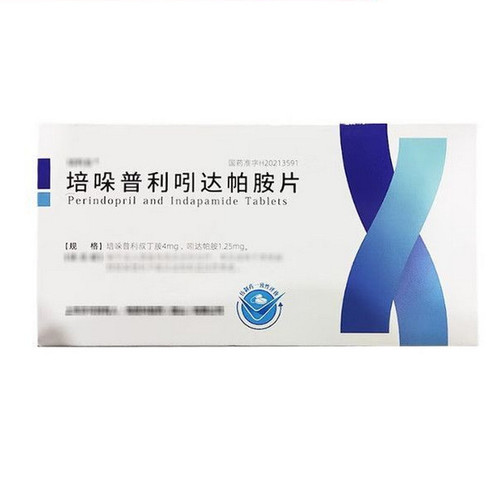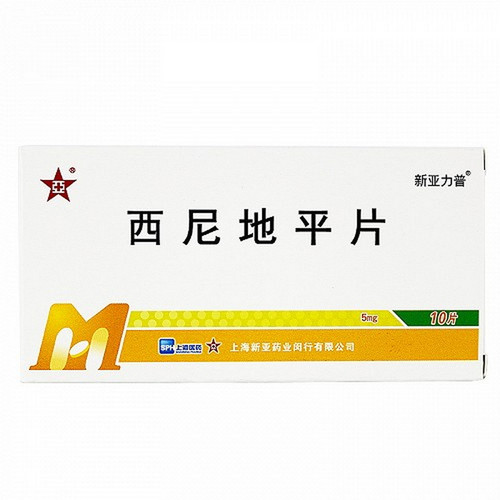Product Overview
[Drug Name]
Generic Name: Perindopril Tert-Butylamine Tablets
Trade Name: Yitai Perindopril Tert-Butylamine Tablets 2mg*24 Tablets
Pinyin Full Code: YiTai PeiZuoPuLiShuDingAnPian 2mg*24 Tablets
[Main Ingredient]
Perindopril Tert-Butylamine
[Properties]
This product is white or off-white tablets.
[Indications/Main Functions]
Hypertension and congestive heart failure.
[Specifications]
2mg*24 tablets
[Dosage and Administration]
Perindopril tablets must be taken before meals because food alters the bioavailability of its active metabolite, perindoprilat. Perindopril should be taken once daily. For essential hypertension without sodium depletion or renal failure (i.e., normal conditions): The effective dose is 4 mg/day, taken once in the morning. Based on efficacy, the dose can be gradually increased over three to four weeks to a maximum of 8 mg/day. If necessary, a potassium-wasting diuretic can be used concomitantly to further lower blood pressure. · Hypertensive patients who have been treated with diuretics (1) Stop taking diuretics three days before starting treatment. If necessary, diuretics can be added again later. (2) Or start treatment with 2 mg and adjust the dose according to the antihypertensive effect. It is recommended to monitor blood creatinine and blood potassium levels before treatment and within the first 15 days of treatment. · Elderly people (see: Precautions) Start treatment with a low dose (2 mg/day, taken in the morning) and increase to 4 mg/day after one month if necessary. If previous examinations show that renal function abnormalities are not caused by age, the dose can be adjusted according to the patient's renal function status if necessary (see: Table below). Creatinine clearance can accurately reflect the renal function of the elderly. Creatinine clearance is based on blood creatinine and is corrected by age, weight and sex. It is calculated using Cockroft's formula: *CIcr=(140-age)×weight/0.814×blood creatinine Use: years for age, dry grams for weight, mmol/l for blood creatinine This formula is applicable to adult males, and women should multiply by 0.85 for correction. For renovascular hypertension, the recommended starting dose is 2 mg/day, with subsequent dose adjustments based on the patient's blood pressure response. Serum creatinine and potassium levels should be monitored to detect the presence of functional renal insufficiency. (See: Precautions.)In patients with renal insufficiency, the perindopril dose should be adjusted according to the degree of renal insufficiency: If the creatinine clearance is ≥60 mL/min, no dose adjustment is required. If the creatinine clearance is <60 mL/min, refer to the following table: Creatinine Clearance (mL/min) Recommended Dose 30 < CCl < 60 2 mg/day 15 < CCl < 30 2 mg/every other day Typical medical management for these patients includes regular monitoring of serum potassium and creatinine, such as every two months during stable treatment. In these cases, aldosterone-inhibiting diuretics may be used concomitantly. For hypertensive patients undergoing hemodialysis (CCl <15 mL/min), perindopril is dialyzable (See Warnings: Hemodialysis). The dialysis clearance rate is 70 m/min. Administer 2 mg of perindopril on the day of dialysis. Treatment for congestive heart failure should be initiated with a low dose, particularly in the following cases: · Low or normal initial blood pressure · Renal failure · Hyponatremia, whether or not drug-induced (diuretic) ACE inhibitors can be used in combination with diuretics, and digitalis glycosides can be added if necessary. It is recommended to start treatment with 2 mg daily in the morning, while monitoring blood pressure. If necessary, increase to the usual therapeutic dose of 2-4 mg once daily. The selected daily therapeutic dose should achieve an upright systolic blood pressure of no less than 90 mmHg. Patients with high-risk heart failure (severe heart failure, patients receiving diuretic therapy) may experience symptomatic hypotension after treatment. The starting dose for such patients should be halved (i.e., 1 mg/day). Serum potassium and creatinine should be monitored with each dose increase and every 3-6 months, depending on cardiac function classification, to assess the safety of treatment. See the package insert for details.
[Adverse Reactions]
Clinical Side Effects: 1. Headache, fatigue, dizziness, mood or sleep disturbances, cramps. 2. Orthostatic or non-orthostatic hypotension (see: Precautions). 3. Rare cases of rash. 4. Stomach pain, anorexia, nausea, abdominal pain, and dysgeusia. 5. Dry cough has been reported in association with ACE inhibitor use. This cough is characteristically persistent but resolves after discontinuation of the drug. If this occurs, consider considering the drug as a possible cause. 6. Very Rare: Angioedema (see: Warnings). Effects on Laboratory Parameters: 1. Moderate elevations in blood urea and creatinine, which resolve after discontinuation of treatment. These elevations are more common in patients with renal artery stenosis, hypertension, or renal failure receiving diuretic therapy. 2. In patients with glomerulonephropathy, ACE inhibitors may induce proteinuria. 3. Hyperkalemia, usually transient. 4. Anemia (see: Precautions) has been reported in patients receiving ACE inhibitors in specific patient groups (renal transplant recipients and hemodialysis patients). See package insert for details.
[Contraindications]
1. Hypersensitivity to perindopril. 2. History of angioedema associated with ACE inhibitor use. 3. Pregnancy during the fourth to ninth trimester. 4. Breastfeeding. Perindopril is not recommended in the following situations: 1. Concomitant use with potassium-sparing diuretics, potassium salts, lithium salts, or estradiol mustard (see Drug Interactions). 2. Bilateral or unilateral renal artery stenosis. 3. Hyperkalemia. 4. During the first trimester of pregnancy and during breastfeeding. See package insert for details.
[Precautions]
Special Warning: Because this drug contains lactose, it is contraindicated in patients with congenital galactosemia. Patients with this condition have malabsorption of glucose and galactose or lack lactase. There is a risk of neutropenia/agranulocytosis in immunosuppressed patients. Agranulocytosis and/or myelosuppression have rarely occurred when ACE inhibitors are taken in the following ways: · High doses · Patients with renal failure caused by multisystem diseases (collagenous diseases such as systemic lupus erythematosus or scleroderma) · Patients with concomitant immunosuppressive therapy and/or treatments that may cause leukopenia. The best way to prevent these events is to strictly adhere to the recommended dosage. However, if ACE inhibitors are necessary for these patients, the risk/benefit ratio should be carefully evaluated. Angioedema (Quindopril edema) has been reported in rare cases in patients taking ACE inhibitors, including perindopril. Angioedema can occur in the face, extremities, lips, tongue, glottis, and/or larynx. In such cases, perindopril should be discontinued immediately, and the patient should be monitored until the edema resolves. Edema limited to the face and lips generally resolves without treatment, but antihistamines can be used to alleviate symptoms. Laryngeal edema associated with angioedema can be fatal. Edema of the tongue, glottis, and/or larynx can lead to airway obstruction and should be treated immediately with 1/1000 epinephrine solution (approximately 0.3 ml to 0.5 ml subcutaneously) and other appropriate treatment. ACE inhibitors should never be used in such patients (see Contraindications). Patients with a history of angioedema unrelated to ACE inhibitor therapy are at increased risk of developing angioedema when taking ACE inhibitors. Anaphylactoid reactions have been reported in patients using dialysis membranes. Delayed, life-threatening anaphylactic-like reactions have occurred in patients receiving dialysis with hypertonic membranes or glycosylated sulfate adsorption for low-density lipoprotein apheresis concurrently with ACE inhibitors. ACE inhibitors should be avoided in patients receiving dialysis with hypertonic membranes or glycosylated sulfate adsorption for low-density lipoprotein apheresis. Patients requiring concurrent treatment with angiotensin-converting enzyme (ACE) inhibitors and undergoing plasma LDL apheresis should temporarily discontinue ACE inhibitor therapy for at least 24 hours to avoid these adverse reactions. Precautions: Cough: A dry cough has been reported in patients taking ACE inhibitors. It is characteristically persistent and resolves after discontinuation of therapy. If it occurs, the symptom should be considered drug-induced. If ACE inhibitor therapy is necessary, treatment can be continued. In rare cases, ACE inhibitors have been associated with cholestatic jaundice, which can progress to sudden hepatic necrosis and death. The mechanism of this symptom is unknown. Patients receiving ACE inhibitor therapy who develop jaundice or significant liver enzyme elevations should have their ACE inhibitor discontinued and receive appropriate medical follow-up. Risk of hypotension and/or renal failure (in cases of heart failure, water and sodium depletion) Significant stimulation of the renin-angiotensin-aldosterone system is particularly important in patients with severe water and sodium depletion (strict salt-free diet or long-term diuretic therapy), pre-treatment hypotension, renal artery stenosis, congestive heart failure, or cirrhosis with edema and ascites. Because ACE inhibitors block this system, they can cause a sudden drop in blood pressure and/or an increase in serum creatinine (reflecting functional renal failure, manifesting as acute renal failure in some cases) after the first dose and during the first two weeks of treatment. This is rare and occurs at variable times. In all these cases, the dose should be increased gradually (see: Dosage and Administration). Before starting treatment in the elderly, renal function and serum potassium should be checked (see: Dosage and Administration). The initial dose should be adjusted based on changes in blood pressure, and caution should be exercised in patients with water and sodium depletion to avoid a sudden drop in blood pressure. In patients with renal failure (anhydride clearance <60 ml/min) the dose should be reduced (see: Dosage and Administration). Regular monitoring of serum potassium and creatinine levels is standard management for these patients and those with glomerulonephropathy (see: Dosage and Administration). Patients with established arteriosclerosis: Because all these patients are at risk for hypotension, patients with ischemic heart disease or cerebrovascular insufficiency taking this drug should be carefully monitored and started with a low dose. Renovascular hypertension is treated with revascularization. However, for patients awaiting surgical treatment or those who cannot undergo surgery, ACE inhibitors may be effective. Because ACE inhibitor treatment can cause functional renal failure in some patients (reversible upon discontinuation of the drug), treatment should be initiated with a low dose, and renal function and serum potassium levels should be monitored. For other high-risk patients, such as those with severe heart failure (class IV) or insulin-dependent diabetes (who are prone to spontaneous hyperkalemia), treatment should be initiated with a low dose under close medical supervision. Beta-blocker therapy should not be discontinued in patients with hypertension and coronary artery insufficiency. ACE inhibitors can be used in combination with beta-blockers. Anemia: In patients with renal transplantation and hemodialysis, anemia and a decrease in hemoglobin occur after treatment with ACE inhibitors. The decrease is greater with higher initial hemoglobin values. This effect does not appear dose-dependent but appears to be related to the mechanism of action of ACE inhibitors. This decrease in hemoglobin is moderate, occurs over 1-6 months, and then stabilizes. It resolves after discontinuation of treatment. If hemoglobin levels are monitored regularly, such patients can continue treatment. ACE inhibitors can cause hypotension in cases of surgical anesthesia, especially when medications with hypotensive potential are used. If possible, long-acting ACE inhibitors, such as perindopril, should be discontinued two days before surgery. Desensitization or Allergic Reactions Following Insect Stings: Rare cases of delayed, life-threatening anaphylactic-like reactions have been reported in patients undergoing desensitization to venoms of Hymenoptera (bees, wasps) and using ACE inhibitors. Caution should be exercised during the initial phase of desensitization in patients with allergies, and ACE inhibitors must be avoided in patients undergoing venom immunotherapy. Patients requiring concurrent use of ACE inhibitors and desensitization therapy should temporarily discontinue ACE inhibitors for at least 24 hours to avoid these adverse reactions. Effects on the Ability to Drive a Motor Vehicle and Operate Machinery: Because the drug can cause dizziness, motor vehicle drivers and machinery operators should exercise particular caution.








